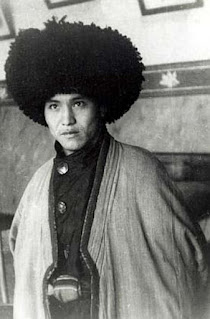Quatbay Utegenov
Trafford Publishing, 2006.
Since I could not find a collection of Uzbek folktales, I got this book instead. The Karakalpaks are a Turkic ethnic group that has belonged to various states in Central Asia, and since 1936 they have been living within the borders of Uzbekistan. The book contains 13 realistic folktales and 8 fairy tales, although sometimes it is hard to tell those two apart. The author is Karakalpak himself; after teaching English for a while he became a Central Asian correspondent for the BBC. In the introduction he gives us a detailed description of Karakalpak history.
The book is a bit larger than it should be (large letters and some strange spacing), but apart from a few editing errors it is an intriguing and enjoyable read.
Highlights
The story of The dispute between the three young men and the clever girl was a very cool version of the "three fastidious men" folktale type. The three brothers - Advisor, Thinker, and Verifier - were seeking justice about their father's inheritance. After they dazzled the khan with their skills (e.g. telling the lamb they ate had been suckled by a dog), they decided he was not wise enough for their needs, so they moved on to a famously clever girl. She told them a dilemma tale, and based on their responses determined which one had been lying about the inheritance. I especially loved that this time the dilemma tale itself ended well - it was a "who deserves this woman the most" type story, where they usually send the poor woman back to a husband she didn't want, but here the girl changed the ending for the better.
The story of Aqyl-Dana and Aqyl-Kamal was interesting for several reasons. It was about a boy and a girl who had been sworn to be siblings by their mothers even before they were born. The boy did not want to go to school, instead he asked his father to build him a library and locked himself in there. Eventually he fell in love with a mysterious girl who visited him, and his sworn sister helped him win her, through all kinds of adventures.
Among the fairy tales I really liked Gulziyba, the daughter of a khan, who accidentally ran away with the wrong guy, went through many adventures, found love, and then helped her husband fulfill a khan's impossible wishes. Part of the story reminded me of the "son of the hunter" folktale type - here, he had to build a palace of tiger teeth. Tigers helped him voluntarily, each donating one tooth, and made a small model palace, since the khan never specified how big it had to be... This tale also featured a return from the underworld on the back of a giant golden eagle.
In another fairy tale, a stepmother chased two siblings into the wilderness; brother and sister raised each other. When a prince wanted to force the girl to marry him, she first yelled at him for not even asking her consent, and next (after the price murdered her brother), she beheaded him. After that she set out into the world, dressed as a man, and managed to win three wives and three magic items that could bring a dead man back to life - thus saving her brother. Bringing someone back from the dead was also a key plot point in the story of Abat-Batyr, whose wife revived him by tracking down three of his old friends who had magical powers.
The tale of Jansap was a long and elaborate story that featured a lot of traveling, adventures, and the classic story of Gemstone Mountain. I especially liked that later on the hero, seeking his lost wife, went back to the evil merchant and got himself sent up the mountain again, to retrace the steps of his journey and find his love.
I enjoyed the part of the story of The mullah's three sons where the mullah proved to be a horrible, abusive teacher who beat and took advantage of students - until his students revolted, and threw him in the outhouse.
Connections
We are still on the Central Asian crossroads of cultures, which means there were many familiar tales and motifs in the book. There was a clever boy telling the khan riddles (and saving his people from taxes); a clever old shepherd who gave mysterious answers to the khan (and cheated his evil ministers out of their money); a clever maiden who was a shepherd's daughter; and one of those stories about an innocent girl who keeps being threatened by men, until she gains control of her own life (Angel Inta).
I encountered a tale I have also heard in the USA, about a clever man (Yesim the mat weaver) who married his mean neighbor's wife. There was a secret tunnel between their houses, and the woman pretended to be her own twin sister. Later on, she helped her new husband get rich with all kinds of clever tricks.
The resident trickster is Aldar-Kose, who here appeared in the company of two other like-minded men, Mukhtar-Kose and Dukhtar-Kose. He tricked both of them (with classics such as "who had the best dream" and "half a shoe lost on the road"), but in the end he teamed up with Dukhtar-Kose to scare a bunch of robbers and get their treasure.
Where to next?
Afghanistan!











No comments:
Post a Comment